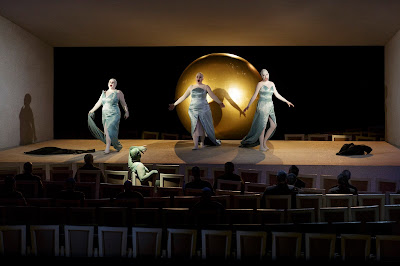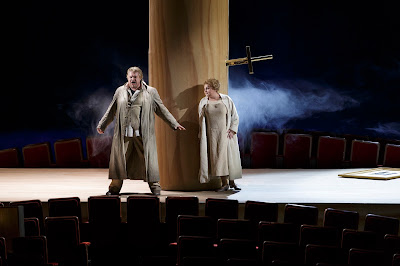 |
| Wagner: The Ring - Semperoper, Dresden - Andreas Schager (Siegfried), Petra Lang (Brünnhilde) (Photo © Klaus Gigga) |
Reviewed by Tony Cooper on Jan 2018
Willy Decker’s Ring cycle is truly loved by the opera cognoscenti of Dresden
Born in the 1950s, German theatre director, Willy Decker - who, by the way, staged the world premières of Hans Werner Henze’s Pollicino (Montepulciano, 1980), Antonio Bibalo’s Macbeth (Oslo, 1990) and Aribert Reimann’s Das Schloss (Berlin, 1992) - delivered a stunning, innovative and telling (but spartan) production of Wagner’s Der Ring des Nibelungen.
Produced in partnership with Teatro Real, Madrid, the production - returning to the stage of Dresden’s Semperoper in January 2018, a jewel of a house - featured such acclaimed Wagnerian singers as Albert Dohmen, Petra Lang, Christa Mayer, Andreas Schager, Vitalij Kowaljow, Gerhard Siegel, Kurt Streit and Georg Zeppenfeld.
And the man in the pit - and a great statesman for Wagner - Christian Thielemann, took charge of the Staatskapelle Dresden of which he’s the musical director with firmness, passion and gusto. His trade-mark, I guess! A busy man, too, he’s also music director of the Bayreuth Festival and of the Salzburg Easter Festival.
 |
| Stephen Milling (Hagen), Albert Dohmen (Alberich) (Photo © Klaus Gigga) |
Dresden, however, harbours a special place in the history of the Ring inasmuch as Wagner first thought about writing about the legend of the Nibelungen while working in the city as Kapellmeister to the Saxon court. In fact, it was at Dresden that the first reading of the draft libretto took place.
Therefore, it seems appropriate to see a Ring production in this city. The production - which is truly loved by the opera cognoscenti of Dresden - worked for me hands down. It was first seen at the Semperoper over fifteen years ago with Das Rheingold and Die Walküre receiving their premières in 2001 while Siegfried and Götterdämmerung followed a couple of years later.
When the curtain went up on Das Rheingold the audience was met by row upon row of theatre-style seating covering the whole area of the Semper’s stage in a wave-like pattern clearly representing the running waters of the Rhine. Here Wotan and his fellow gods were seen scurrying into their seats to witness the unfolding drama of the Rhinemaidens.
Shaven headed and attired in long white-coloured robes they told the legendary tale of the Rhine’s secret treasure portrayed in this production as an enormous golden ball while tantalising and teasing poor old Alberich, chief of the Nibelung, to bursting-point with their seductive and alluring charms. The famed trio - Christiane Kohl (Woglinde), Sabrina Kögel (Wellgunde) and Simone Schröder (Flosshilde) - sung and acted their roles as near perfect as one could get capturing the empathy of their respective characters so well.
 |
| Christiane Kohl (Woglinde), Simone Schröder (Flosshilde), Sabrina Kögel (Wellgunde), Janina Baechle (Erda) (Photo © Klaus Gigga) |
The set designer, Wolfgang Gussmann, working in partnership with Ms Frauke Schernau, too, on costumes, created an economical and imaginative set to say the least by placing the overall action within the confines of a theatre setting. A clever idea, for sure. Therefore, the struggle for the ring was duly carried out within the auditorium making this production as dramatic as they come.
And those characters not involved in any stage action simply became members of the audience. For instance, when Wotan leads the Gods to Valhalla (designed in the style of a Greek classical temple) the rainbow-bridge was, for all intents and purposes, a builder’s-type ramp positioned above the theatre seating while Loge was seen totally relaxed in his seat enjoying this precious moment with Erda (Goddess of the Earth) - sung regally and with such dignity by Janina Baechle who harbours a rich and warm mezzo-soprano voice - capturing the attention of a nervously-looking Wotan unsure of himself as he entered his new kingdom which, of course, he has paid a heavy price for.
 |
| Kurt Streit (Loge), Gerhard Siegel (Mime), Vitalij Kowaljow (Wotan) (Photo © Klaus Gigga) |
The dual role of Wotan/The Wanderer was brilliantly and strongly sung by Ukrainian bass, Vitalij Kowaljow - who previously worked as a fireman in his homeland - while his long-suffering wife, Fricka (Christa Mayer) - Goddess of Marriage - proved quite business-like in her dealings with him offering an intelligent and thoughtful reading of the role standing up to her aggressive, arrogant and wayward husband in no uncertain terms while Freia (Regine Hangler) put in a dramatic and confident performance.
And the brothers of Fricka and Freia - Donner (God of Thunder) and Froh (God of Spring) were dutifully sung by Derek Welton and Tansel Akzeybek while Albert Dohmen played Alberich (a master of the role) aggressively, craftily and nasty as befits this ugly character while his long-suffering brother, Mime, admirably sung by Gerhard Siegel, felt the heat and beat of his anger.
The pastel-coloured theatre seating used in Das Rheingold boldly gave way to a different permutation in Die Walküre inasmuch as they were bright red and set out in an arc-shaped formation that well suited the scene in which Brünnhilde - suitably adorned like the rest of her Valkyries with flaming-red hair, waistcoat and trousers - found herself encircled by fire on her rock.
 |
| Peter Seiffert (Siegmund), Elena Pankratova (Sieglinde) (Photo © Klaus Gigga) |
Petra Lang as Brünnhilde (the first time that she has sung the role at the Semperoper) was athletic and youthful-looking in the part particularly in her tête-à-tête with Wotan explaining the vagaries of power and love to her as well as relating the story of the Nibelheim curse, the power of the ring and, indeed, how Erda gave birth to his favourite Valkyrie.
Their parting and final farewell in the last act of Die Walküre turned out to be a heart-wrenching moment. Both singers put everything they had into this dramatic and well-loved scene. The electricity between them was nothing but high voltage and coupled with extraordinary and thoughtful playing emanating from the pit under Maestro Thielemann, it was exciting stuff to the last bar. Mr Kowaljow and Ms Lang were seemingly on fire (no pun intended) delivering a thrilling climax in a performance that more than fuelled the imagination and roused the senses.
The opening act of Die Walküre, though, calmer and quieter all round, found Georg Zeppenfeld reappear on stage as Hunding attired in a smart tailored two-piece brown suit looking more like a bank manager than a forester. An amazing singer, he delivered a fine reading of this suspicious and sinister character while Peter Seiffert and Elena Pankratova fully stamped their credentials on the demanding brother-sister roles of Siegmund and Sieglinde delivering their great romantic number revealing their true feelings to each other in a powerful and assertive way.
 |
| Vitalij Kowaljow (Wotan), Christa Mayer (Fricka) (Photo © Klaus Gigga) |
He’s worth every penny and his characterisation of this creepy, false and Janus-faced individual worked so well with the Siegfried of Stephen Gould who played his part as a wild and extravagant individual while it was all change for Götterdämmerung with Andreas Schager taking on the role of Mime which he sang so majestically and heroically.
When Siegfried bursts into Mime’s scruffy and unkempt forest hut he’s clutching a large cuddly toy bear (the sort you win on a fairground coconut shie!) discovering Mime bundled up a corner under a heap of old broken chairs frightened to the core with fragments of metal - failed attempts by his scheming guardian of trying to forge the sword Nothung - scattered about.
 |
| Gerhard Siegel (Mime), Andreas Schager (Siegfried) (Photo © Klaus Gigga) |
This momentous and well-loved scene culminated in the demise of Fafner with Georg Zeppenfield reaching the depths of his solid bass voice so effectively while the dragon - which, surely, would wow the crowds at the Notting Hill Carnival - was operated by an eight-person team while Fafner’s forest den was squeezed into a squared fairground-style booth. That really sparked the imagination.
The Woodbird was radiantly sung by Tuuli Takala off stage and acted by Emilian Antoci who also appeared in a doppelgänger role as Young Siegfried to good effect. And that delicate moment in which the Woodbird - who, incidentally, saves Siegfried’s life telling him not to drink Mime’s drugged potion - informs him about the whereabouts of his beautiful bride, it was given a different angle by Mr Decker who simply portrayed her wearing a flaming-red dress. Where was the rock? Somewhere!
 |
| Vitalij Kowaljow (Wanderer), Christa Mayer (Erda) (Photo © Klaus Gigga) |
But, nonetheless, the opera was in keeping with the overall style and presentation of the production and witnessed Gunther and Gutrune, generously played by Martin Gantner and Edith Haller, seen chasing the pleasures of life sipping champagne (maybe trying to help them stave off the realities of life) in the Gibichung Hall which was adorned with a large landscape-designed panelled window offering a romantic view of the Rhine valley so admired by generations of German writers and artists while a large globe dominated one side of the hall and a drinks table the other. Get the picture? Dressed in evening wear they looked uncomfortable within their home environment while Stephen Milling (Hagen), their half-brother and bogus marriage broker, engages in an incestuous relationship with Gutrune. As usual, Mr Milling played his part to the full - mean, demonic and forceful at every turn.
Christa Mayer (Erda was sung by Sylvia Köhler) put in a strong and confident performance as Waltraute. Dressed in a military-style long coat, her encounter with Brünnhilde encouraging her to return the ring to the Rhinemaidens to save the Gods and mankind showed total dedication and sisterly love for her.
 |
| Monika Bohinec, Simone Schröder, Christiane Kohl (Nornen) (Photo © Klaus Gigga) |
And another departure from the libretto saw Gutrune revenging her brother’s death by spearing Hagen (fighting for the ring to the bitter end) to death before collapsing herself within the panic, turmoil and confusion of the ending of the Gods and their beloved heavenly home, Valhalla.
Overall, this was a strong, thoughtful and compelling production which left a lot to one’s imagination. To give one example: the tricky scene in which Alberich boasts to Wotan and Loge about the powers of the Tarnhelm, the magic helmet was none other than a golden-coloured bowler-hat and the Giant was simply portrayed by the hat being suspended high in mid-air while the croaking Toad was represented by the hat being hurriedly passed between Alberich and his two nosey visitors. It was a simple but very imaginative and straightforward piece of staging that kept this intelligent and down-to-earth production alert and interesting recalling for me Wagner’s statement that ‘imagination creates reality’. Indeed, it does!
Reviewed by Tony Cooper
 |
| Wagner: The Ring - Martin Gantner (Gunther), Andreas Schager (Siegfried), Stephen Milling (Hagen), Petra Lang (Brünnhilde) (Photo © Klaus Gigga) |
Sächsische Staatskapelle Dresden
Staatsopernchor. Chor: Jörn Hinnerk Andresen
Inszenierung: Willy Decker
Bühnenbild: Wolfgang Gussmann
Kostüme: Frauke Schernau, Wolfgang Gussmann
Dramaturgie: Klaus Bertisch
Wotan/Der Wanderer: Vitalij Kowaljow
Donner: Derek Welton
Froh: Tansel Akzeybek
Loge: Kurt Streit
Alberich: Albert Dohmen
Mime: Gerhard Siegel
Fasolt: Georg Zeppenfeld
Fafner: Karl-Heinz Lehner
Fricka: Christa Mayer
Freia: Regine Hangler
Erda: Janina Baechle / Christa Mayer / Sylvia Köhler
Woglinde: Christiane Kohl
Wellgunde: Sabrina Kögel
Flosshilde: Simone Schröder
Siegmund: Peter Seiffert
Hunding: Georg Zeppenfeld
Sieglinde: Elena Pankratova
Brünnhilde: Petra Lang
Helmwige: Christiane Kohl
Gerhilde: Johanna Winkel
Ortlinde: Brit-Tone Müllertz
Waltraute: Irmgard Vilsmaier / Christa Mayer
Siegrune: Julia Rutigliano
Roßweiße: Simone Schröder
Grimgerde: Sabrina Kögel
Schwertleite: Katharina Magiera
Siegfried: Andreas Schager
Waldvogel: Tuuli Takala
Gunther: Martin Gantner
Gutrune: Edith Haller
Hagen: Stephen Milling
First Norn: Monika Bohinec
Second Norn: Simone Schröder
Third Norn: Christiane Kohl










%20and%20kids.jpg)
No comments:
Post a Comment